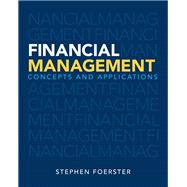A balanced overview of financial management theory and practice
Finance is one of the key drivers of a firm’s activities, and a critical component to understanding business in general. Financial Management: Concepts and Applications is designed to help students with no prior knowledge grasp the applications and relevance of finance. Author Stephen Foerster reveals the practical side of finance, rather than just its theoretical concepts, and shows how finance intersects with many other areas of business. Thoroughly integrated with the text, MyFinanceLab places personalized practice opportunities just a few clicks away and provides a truly interactive learning experience.
This program provides a better teaching and learning experience—for you and your students. It will help you to:
• Personalize learning with MyFinanceLab: This online homework, tutorial, and assessment program provides students the help they need, when they need it, and allows unlimited practice.Note: If you are purchasing the standalone text or electronic version, MyFinanceLab does not come automatically packaged with the text. To purchase MyFinanceLab please visit www.myfinancelab.com or you can purchase a package of the physical text + MyFinanceLab by searching for 0133578089 / 9780133578089. MyFinanceLab¿ is not a self-paced technology and should only be purchased when required by an instructor.
• Encourage students to focus on the big picture: A thematic approach helps students achieve a holistic view of how finance impacts many aspects of business.
• Highlight applications of finance: A strong emphasis on applications helps students see the relevance of finance, and keeps them interested in the course.
• Foster thorough understanding via learning aids: Various tools, throughout the text and at the end of each chapter, support students as they learn and review.








